Xerocomus Quél.
Recent molecular studies have shown that Xerocomus in its current circumscription is likely an artificial grouping and it is possible that it will be split at some point into smaller genera. Molecular studies also have changed our understanding about the species of xerocomoid boletes showing that morphological features are quite variable in this group. Not only microscopic study is essential for determination, but scanning electron microscope will be often needed in this “genus” as the spore ornamentation is not always seen under ordinary light microscope. Do bear in mind that macroscopic characters, such as colours, cracking cuticle, etc., tend to intergrade between the different species. Note that Boletus impolitus and Boletus depilatus that were shown to be close to Xerocomus subtomentosus and its allies, are here retained in Boletus for practical reasons. The same applies also for Phylloporus pelletieri, placed here in a genus of its own, but being also close to Xerocomus subtomentosus group.
Although large reference list will be found under most of the species, one should always consult Ladurner & Simonini (2003) having in mind that there are some new species (X. chrysonemus, X. marekii, X. silwoodensis) described after this otherwise superior book was printed. Useful keys, covering most of the European xerocomoid boletes (except some southern taxa) are provided by Knudsen & Vesterholt (2008), Hills (2008) and Kibby (2011), the later also featuring an excellent comparison chart.
Fruitbody medium to small sized, boletoid, without veil and ring. Stipe solid, often tapering towards the base. Flesh variously coloured, changing or not when exposed to air. Tubes not separable from each other, instead tearing apart. Pores usually angular.
Xerocomus bubalinus (Oolbekkink & Duin) Redeuilh
Description
Cap up to 5 cm, at first hemispherical, later convex to flattened, ochraceous, buff with or without apricot hues, pale brown, reddish brown, yellow brown to coppery brown, usually paler towards the cap margin, dry, velvety, later smooth or very finely cracked. Stipe cylindrical, ventricose or club-shaped, yellowish and usually covered throughout with very fine red granules, often discolouring with age, blueing when bruised. Tubes pale yellow to yellow with olivaceous tint, blueing when injured. Pores concolorous with the tubes, blueing when bruised. Flesh whitish in the cap, distinctly pinkish below the cap cuticle, yellowish in the stipe, orange brown in the stipe base, sometimes with few orange-red dotes, blueing in the cap. Smell not distinctive. Taste not distinctive. Spores 11–15 × 4.5–5 μm, smooth. Pileipellis palisadoderm of septate hyphae of cylindrical or rounded, slightly incrusted cells.
Habitat. In urban areas, parks, lawns, mycorrhizal with poplars (Populus) or lime (Tilia). One record with hornbeam (Carpinus) from Britain. It is suggested by the literature and by my own observations that the range of mycorrhizal hosts is probably wider and includes birch (Betula), beech (Fagus) and spruce (Picea).
Distribution. Not yet fully understood. Recorded from Bulgaria, France, Hungary, Italy, Netherlands, Norway, Sweden and UK. Apparently more widespread that previously thought but possibly neglected.
Similarity. Similar to Xerocomus communis and X. rubellus and macroscopically recognized by the pinkish hue of the flesh in the cap. It was previously considered that X. bubalinus does not feature red dots seen in the flesh in the stipe base of both X. communis and X. rubellus. However Gelardi (2010) recently noted that they are also seen in X. bubalinus albeit rarely. Compare also with Xerocomus erubescens.
Photographs
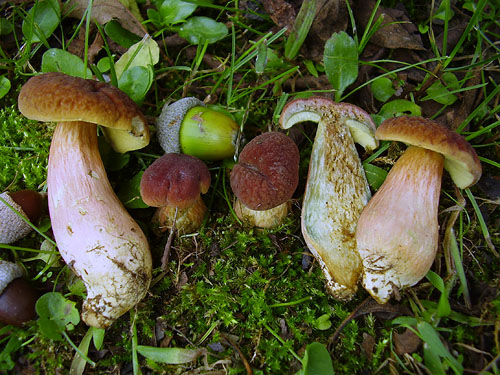
Fruitbodies of Xerocomus bubalinus. Here and below note the great colour variability. The characteristic pinkish tint of the flesh under the cap cuticle is also easily seen. (photo M. Gelardi)
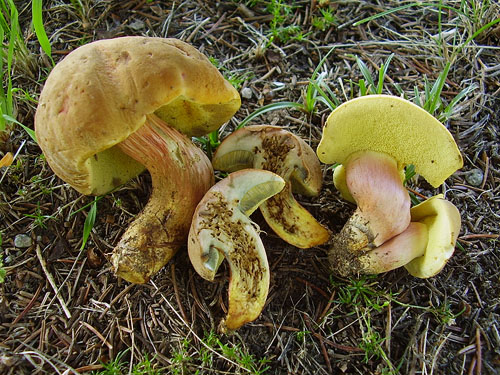
Fruitbodies of Xerocomus bubalinus. (photo M. Gelardi)
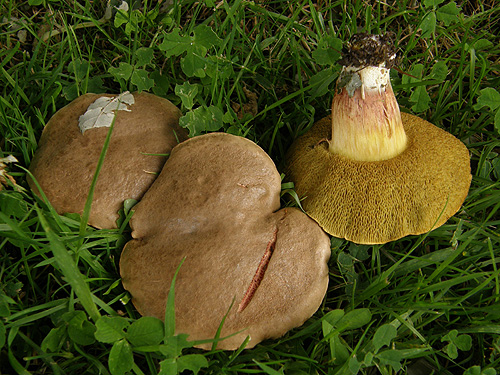
- Fruitbodies of Xerocomus bubalinus. Note the colour of the cap. (photo B. Assyov)
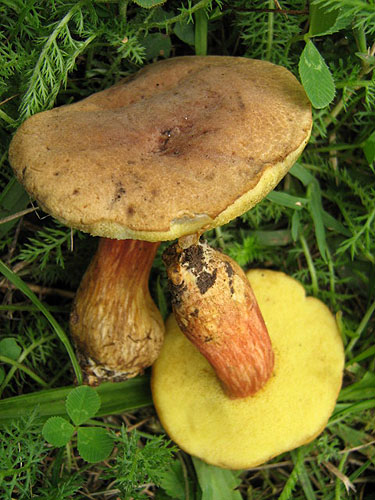
Fruitbodies of Xerocomus bubalinus. (photo D. Stoykov)
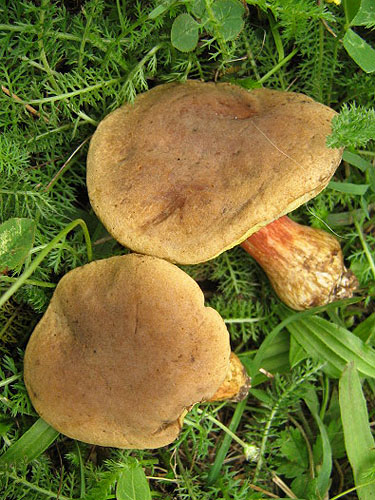
Fruitbodies of Xerocomus bubalinus. (photo D. Stoykov)
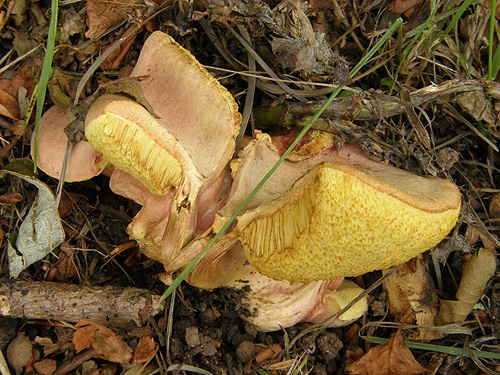
Fruitbodies of Xerocomus bubalinus. Note the pinkish tint on the cap that is sometimes seen in this species as well the pinkish flesh seen where the fruitbody was cracked. (photo B. Assyov)
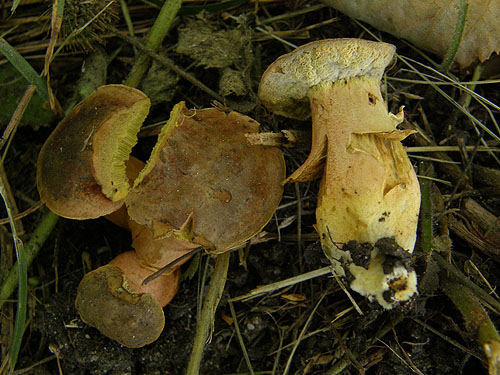
Young fruitbodies of Xerocomus bubalinus. (photo B. Assyov)
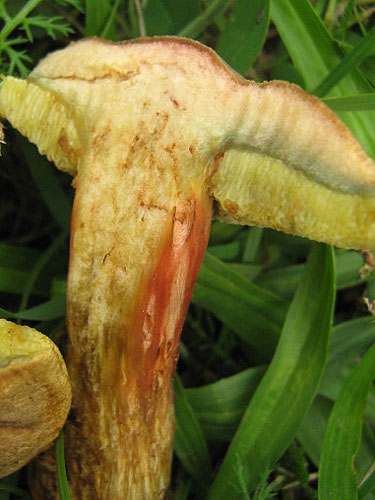
Xerocomus bubalinus - colour of the flesh. Note the pinkish hue under the cap cuticle and the blueing above the tubes. (photo D. Stoykov)
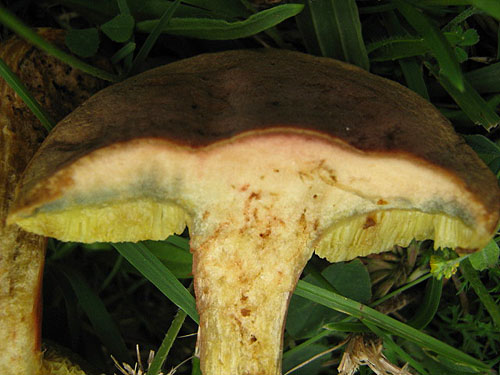
Another photograph of the flesh of Xerocomus bubalinus. (photo D. Stoykov)
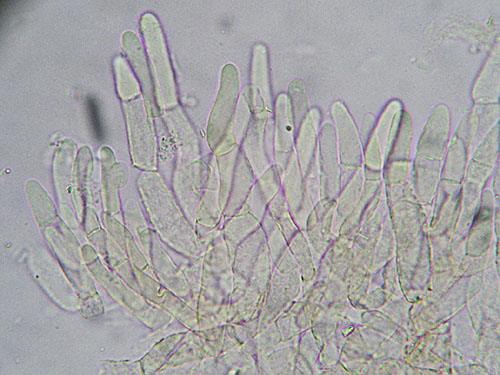
Detail of the cap cuticle of Xerocomus bubalinus - a palisadoderm of moderately incrusted hyphae. (photo B. Assyov)
Important literature
Assyov, B. & Stoykov, D.Y. 2011. Boletus bubalinus (Boletaceae). A new addition to the mycota of Bulgaria and the Balkans. – Comptes rendus de l’Académie bulgare des Sciences 64: 1585–1589. (available online)
Engel, H., Dermek, A., Klofac, W., Ludwig, E. & Brückner, T. 1996. Schmier – und Filzröhrlinge s. l. in Europa. Die Gattungen Boletellus, Boletinus, Phylloporus, Suillus, Xerocomus. Verlag Heinz Engel, Weidhausen b. Coburg.
Gelardi, M. 2009. First record of Xerocomus bubalinus in Italy and the generic placement of Xerocomus engelii comb. nov. – Bolletino dell’Associazione Micologica ed Ecologica Romana 75–76(3–1): 11–20.
Gelardi, M. 2010. Additional data and iconography concerning Xerocomus bubalinus from Central and Northern Italy. – Bolletino dell’Associazione Micologica ed Ecologica Romana 80–81(2–3): 13–21.
Knudsen, H. & Vesterholt, J. [eds.]. 2008. Funga Nordica. Nordsvamp, Kopenhagen.
Ladurner, H. & Simonini, G. 2003. Xerocomus s.l. – In: Fungi Europaei. Vol. 8. Pp. 1–527. Edizioni Candusso, Alassio.
Oolbekkink G.T. 1991. The taxonomic value of the ornamentation of spores in ‘the Xerocomus-group’ of Boletus. – Persoonia 14: 245–273.
Péan, R. & Mornand, J. 2009. Le bolet du peuplier en Anjou – Xerocomus bubalinus. – Cahiers Mycologiques Nantais 21: 8–10+24. (available online)